Click on images to enlarge

infestation (Photo: Sheldon Navie)

habit (Photo: Sheldon Navie)

stems and leaves (Photo: Sheldon Navie)
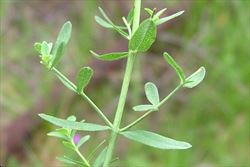
close-up of stem with branches in opposite pairs at an angle of about 45° (Photo: Sheldon Navie)

close-up of leaf undersides showing small oil glands (Photo: Sheldon Navie)
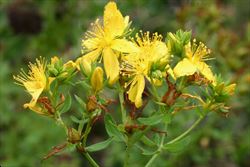
flower clusters (Photo: Trevor James)

yellow flowers with numerous stamens (Photo: Sheldon Navie)
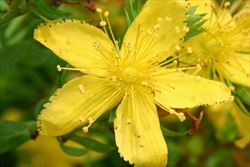
close-up of flower showing small black dots along the edges of the petals (Photo: Trevor James)

immature fruit (Photo: Sheldon Navie)
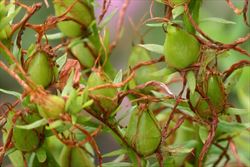
close-up of immaturre fruit (Photo: Trevor James)
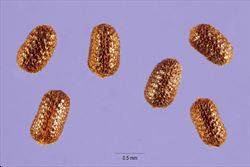
close-up of seeds (Photo: Steve Hurst at USDA PLANTS Database)

the similar native small St. John's wort (Hypericum gramineum), has smaller leaves and flowers (Photo: Sheldon Navie)

the similar native matted St. John's wort (Hypericum japonicum), has smaller leaves and flowers and creeping stems (Photo: Sheldon Navie)
Scientific Name
Hypericum perforatum L.
Synonyms
Hypericum perforatum L. subsp. veronense (Schrank) H. Lindb.Hypericum perforatum L. var. angustifolium DC.Hypericum veronense Schrank
Family
Clusiaceae (Queensland, New South Wales, the ACT, Victoria, Tasmania, Western Australia and the Northern Territory)Guttiferae (South Australia)
Common Names
common St. John's wort, common St. Johnswort, devil's flight, gammock, goatsbeard, goatweed, herb John, Klamath weed, Klamathweed, penny John, perforate St. John's wort, perforated St. John's wort, rosin rose, St John's blood, St John's grass, St. John's wort, St. Johnswort, Tipton weed, touch and heal, witch's herb
Origin
Native to most of Europe, the Azores, the Madeira Islands, the Canary Islands, north-western Africa (i.e. northern Algeria, Morocco and Tunisia), western and northern Asia (i.e. Saudi Arabia, Afghanistan, Cyprus, Iran, Iraq, Lebanon, Syria, Turkey, Armenia, Azerbaijan, Georgia, Russia, Kazakhstan, Kyrgyzstan, Tajikistan, Turkmenistan, Uzbekistan and Mongolia), China and the Indian Sub-continent (i.e. northern Pakistan and India).
Cultivation
St. John's wort (Hypericum perforatum) is sometimes cultivated for use as a medicinal herb.
Naturalised Distribution
Widely naturalised in southern and eastern Australia. It is most common in eastern and southern New South Wales, the ACT, Victoria, south-eastern South Australia and south-western Western Australia. Less common or occasionally naturalised in other parts of South Australia and Western Australia, in Tasmania, and in south-eastern Queensland.
Also naturalised overseas in southern Africa, Japan, Hawaii, the Mascarenes, New Zealand, North America, the Caribbean and South America.
Habitat
This species is mostly found in upland temperate regions, but is occasionally also found in lowland areas and sub-tropical environments. It is a weed of pastures, open woodlands, grasslands, forest plantations, roadsides, railways, river banks and waste areas.
Habit
A long-lived (i.e. perennial) herbaceous plant usually growing 30-70 cm tall, but occasionally reaching up to 1.2 m in height. It normally produces several upright (i.e. erect) stems each year from a woody rootstock.
Distinguishing Features
- an upright and long-lived herbaceous plant usually growing 30-70 cm tall.
- it usually produces several stems each year from a woody rootstock.
- these stems are somewhat woody near the base and have paired branches in their upper halves.
- its relatively small leaves are oppositely arranged, stalkless, hairless and light green in colour.
- its bright yellow flowers (1-3 cm across) often have small black dots along the edges of their petals.
- its reddish-brown capsules (5-10 mm long) split open when mature.
Stems and Leaves
The stems are somewhat woody at the base and are branched mostly in their upper halves. These branches usually occur in opposite pairs at an angle of 45° to the main stem. Younger stems are hairless (i.e. glabrous), often reddish in colour, and have two lengthwise (i.e. longitudinal) ridges.
The relatively small leaves (5-30 mm long and 1.5-12 mm wide) are oppositely arranged, stalkless (i.e. sessile), hairless (i.e. glabrous) and light green in colour. They are egg-shaped in outline (i.e. ovate) to elongated (i.e. lanceolate) in shape and have entire margins. The leaves are dotted with numerous small oil glands which can be seen when held up to the light.
Flowers and Fruit
The bright yellow flowers (1-3 cm across) are borne in small clusters at the tips of the branches. These flowers have five elongated petals, often with small black dots along their edges, and numerous prominent stamens. Flowering occurs mostly during late spring and summer.
The fruit is a small capsule (5-10 mm long) containing numerous tiny seeds. These fruit are green and sticky when young, but turn reddish-brown or brown in colour and split open when fully mature. The seeds (about 1 mm long and 0.5 mm wide) are dark brown or blackish in colour, almost cylindrical in shape, and have a pitted or finely patterned (i.e. reticulate) surface.
Reproduction and Dispersal
This species reproduces by seed and also via creeping underground stems (i.e. rhizomes).
Seeds are dispersed by water, animals, vehicles and wind. They may also be transported in mud, soil and contaminated agricultural produce. Localised spread of colonies also occurs via the rhizomes, which can also be dispersed some distance during cultivation or other activities that disturb the soil.
Environmental Impact
St. John's wort (Hypericum perforatum) is regarded as a significant environmental weed in Victoria and as an environmental weed in the ACT, New South Wales, South Australia and Western Australia. It is actively managed by community groups in Victoria, New South Wales and the ACT, and is listed as a priority environmental weed in six Natural Resource Management regions.
Legislation
This species is declared under legislation in the following states and territories:
- ACT: C3 - a pest plant that must be contained.
- New South Wales: Class 3 - a regionally controlled weed. The relevant local control authority must be promptly notified of the presence of this weed and it must be fully and continuously suppressed and destroyed (in a large number of local authority areas). Class 4 - a locally controlled weed. The growth and spread of this species must be controlled according to the measures specified in a management plan published by the local control authority and the plant may not be sold, propagated or knowingly distributed (in a large number of local authority areas). See the New South Wales Department of Primary Industries Noxious Weeds List at http://www.dpi.nsw.gov.au for more detailed information on which local areas are covered in these declarations.
- Tasmania: D - the importation or sale of this species is prohibited and measures to reduce its population in an area, eradicate it from an area, or restrict it to a particular area may be required.
- Victoria: P2 - prohibited and must be eradicated or controlled (in the Corangamite and Port Phillip West regions), and C8 - all reasonable steps must be taken to control the weed and prevent its spread (in the Wimmera, Glenelg, North Central, Port Phillip East, Goulburn, North East, West Gippsland and East Gippsland regions).
- Western Australia: P1 - trade, sale or movement into the state prevented, and P2 - to be eradicated (throughout the majority of the state). See the Western Australian Department of Agriculture and Food Declared Plant List at http://www.agric.wa.gov.au/ for more detailed information about which areas are covered by these declarations.
Management
For information on the management of this species see the following resources:
- the Victorian Department of Primary Industries Pest Plant Note and Biological Control Notes on this species, which are both available online at http://www.dpi.vic.gov.au.
- the New South Wales Department of Primary Industries Agfact on this species, which is available online at http://www.dpi.nsw.gov.au.
Similar Species
St. John's wort (Hypericum perforatum) is similar to Canary Island St. John's wort (Hypericum canariense), St. Peter's wort (Hypericum tetrapterum), tangled hypericum (Hypericum triquetrifolium) and the native small St. John's wort (Hypericum gramineum) and matted St. John's wort (Hypericum japonicum). These species can be distinguished by the following differences:
- St. John's wort (Hypericum perforatum) has relatively small and narrow leaves (5-40 mm long and 1.5-12 mm wide) that are narrowly egg-shaped in outline (narrowly-ovate) to elongated (i.e. lanceolate or linear) in shape. The yellow flowers are relatively large (1-3 cm across) and their petals are much longer than their sepals. Its fruit are dry capsules (5-10 mm long) that turn brown when they mature.
- Canary Island St. John's wort (Hypericum canariense) has relatively large and narrow leaves (2-7 cm long and 1-2 cm wide) that are narrowly oval (i.e. elliptic) to elongated (i.e. lanceolate) in shape. The yellow flowers are relatively large (2.5-3 cm across) and their petals are much longer than their sepals. Its fruit are dry capsules (5-10 mm long) that turn brown when they mature.
- St. Peter's wort (Hypericum tetrapterum) has relatively small leaves (up to 3 cm long) that are egg-shaped in outline (i.e. ovate) to narrowly oval (i.e. elliptic) in shape. The yellow flowers are relatively small (about 12 mm across) and their petals are much longer than their sepals. Its fruit are dry capsules (5-10 mm long) that turn brown when they mature.
- tangled hypericum (Hypericum triquetrifolium) has small leaves (5-15 mm long) that are arrowhead-shaped and usually borne closely appressed to the stems. The yellow flowers are relatively small (10-15 mm across) and their petals are much longer than their sepals. Its fruit are small dry capsules (3-4 mm long) that turn brown when they mature.
- small St. John's wort (Hypericum gramineum) is a very small plant with small leaves (5-13 mm long) that are egg-shaped in outline (i.e. ovate) to elongated (i.e. lanceolate) in shape. The yellow flowers are small (5-12 mm across) and their petals are usually longer than their sepals. Its fruit are small dry capsules (up to 7 mm long) that turn brown when they mature.
- matted St. John's wort (Hypericum japonicum) is a very small plant with small leaves (2-8 mm long) that are egg-shaped in outline (i.e. ovate) to oblong in shape. The yellow flowers are small (3-8 mm across) and their petals are usually longer than their sepals. Its fruit are small dry capsules (up to 7 mm long) that turn brown when they mature.

